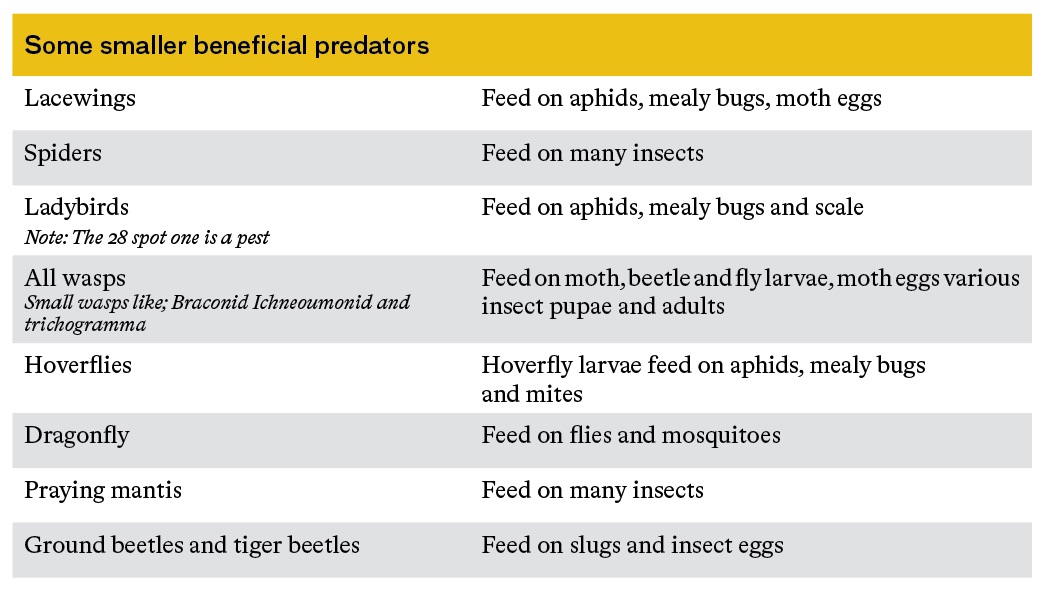Managing pests using nature – part two
There are many causes for pests. Prevention, through planning and design, I recommend as the first step in managing pests naturally then observation and monitoring and then control.
Most insects are not harmful. They are an important part of the food chain and perform valuable work as pollinators, herbivores, carnivores and decomposers. Less than 0.1 percent of the resident insects in your garden can be considered pests, and most of the rest are at work.
When your garden is in balance, problems tend to self-correct. Pests are a species out of balance and a pest-build up is an indication that something is out of balance in your garden such as your soil is too dry or wet.
In your observation identify what is out of balance, recognise common insect pests and their lifecycles and determine if the pests are at an acceptable level where minimal harm is occurring. Through skilled observation and deduction looking at the plant, the soil and the amount of damage – you may decide to do nothing as you can live with a certain amount of damage.
If you are trying to solve a specific pest problem as it has got out of hand, use your observational skills to determine the conditions of the outbreak. Build up your knowledge so you become well prepared, and the damage will become minimal. If you already know the pest, then identify the stage in its lifecycle when it is most vulnerable and intervene then. You can identify the pest by if it chews? Or sucks? Caterpillars, snails and slugs chew – aphids, thrips, scale suck.
And remember once you have applied any technique monitor its effectiveness.
Pest and disease management is approached in permaculture through the integration of four main strategies, which focus on working with nature.
Cultural practices
In a home garden keep soil healthy through techniques such as cover crops, which are planted sacrificially to remove or deter pests before growing susceptible crop. Crop rotation and timing – rotate crops to stop any build-up of soil and diseases. Generally, don’t follow up by planting members of the same family in the same bed. Grow early or late varieties to avoid plants maturing in the peak season where pests are often a problem. Winter turnover of soil can destroy over wintering larvae exposing them to predator birds.
Interplanting/mixed cropping – A single plant crop is known to have pests build up because their food is continuous. So, plant mixed rows of vegetables – go slow and choose the right varieties, which work together and monitor. Regulated and appropriate watering systems – soils have a water holding capacity and so do plants so water accordingly to avoid stressing plants and drowning soil life. Mornings and evenings are the best times to water. Keeping soils mulched moderates the temperature and moisture loss/gain.
Biological diversity is about creating gardens that encourage and provide habitat for predators so they can do their natural work of feeding on pests. This requires providing a home such as rocks, small logs, dense small leaved shrubs for small birds, food – sacrificial fruiting trees – and water.
Many plants such as Yarrow, Dill, Fennel, Queen Anne’s lace, Tansy, white Cosmos, and Pennyroyal attract beneficial insects – it’s a good idea to plant them among your vegetables or in your borders.

Mechanical methods
Reducing pests by creating barriers or removing them by hand does the least damage to your garden ecosystem. Place sawdust, sharp sand and/or ash around special plants or beds as a barrier to slugs and snails.
Bands made from cardboard or old cloth wrapped around trees helps deter crawling insects and pests that overwinter in the soil from climbing up the tree.
Collars – placing collars made from recycling cardboard and pushed five cm into the soil over the seedlings keeps pests out particularly at their vulnerable time of early growth.
Traps – I have heard upturned citrus shells and stale beer in bottles are all good traps.
Lures and baits – Yeasts, sugars and proteins are baits for fruit fly. Decoy plants are used to attract pests.
Exclusions
Netting beds and bagging fruit keeps pests out. However, ensure you only net your vegie beds after your plants have been pollinated and make sure you get a net with holes small enough that keep the pests out.
Handpicking – if you don’t have too much of an infestation you can handpick off grubs and eggs daily or pull off the leaves.
Natural pesticides
I refer you to Robin Stewart’s book Chemical free pest control. •
Photo: Hacı Elmas, Unsplash.

Jo Ryan unveils Ordered Chaos at Blender Studios





 Download the Latest Edition
Download the Latest Edition